Building of the Month - June 2016


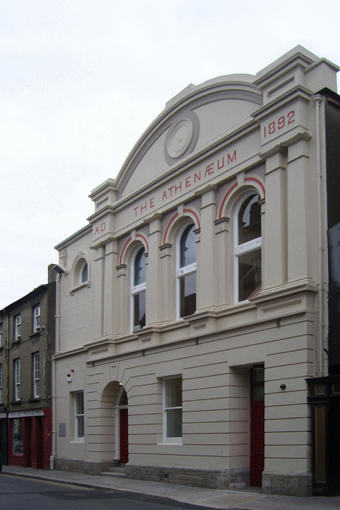 |
A meeting held on Wednesday 4th February 1891 set in motion plans for one of the most important public buildings in Enniscorthy, County Wexford, a building intended for the cultural improvement of the town and its people but which found itself as an accidental centre of revolution in the early twentieth century. The venue for the meeting was the market house in Market Square and, addressing an audience of clergymen, dignitaries and local businessmen, Reverend William Fortune (1848-1925) expressed the need for ‘a new town hall for Enniscorthy’ where young Catholic men could assemble and apply themselves to the arts, literature and science. Fortune is reported to have said that ‘a good reading room is almost as indispensable to social life as a good schoolmaster is to a school’, further saying that ‘some of the most practical and influential men are those who have educated themselves, some of whom have gone on to occupy some of the highest positions in the land’. In conclusion, Fortune remarked that ‘man is a social being, and I am sorry to say that for the want of a hall, the people of Enniscorthy have not been at liberty to exercise much social life in the past’. |
.jpg)
An extract from the Ordnance Survey published in 1886 showing the vacant site selected by the committee for The Athenæum as it allowed for a custom-built hall; an alternative site, in Market Square, called for the adaptation of an existing building. Another consideration may have been its proximity to the Church of Ireland Church Institute on the corner of Castle Street and Church Street and a sense of the ensuing rivalry can be found in the pages of The People when, in 1892, the Chairman of the YMCA, Reverend Arthur Robinson Barton (1846-1900), addressed a large audience and ‘went on to say that he had heard a number of parties interested in the Athenæum were about to apply for a license which would enable them to establish A BAR in that building and sell drink on the premises. The rev. speaker expressed the hope that such a rumour was not true, and he would be sorry to see drink introduced to such a place, there being already in the town far too many public houses’ (The People 5th November 1892)
A committee was duly elected and, advancing the project at a rapid pace, two potential sites were inspected the very next day. The first site, in Market Square, called for the adaptation of an existing building at an estimated cost of £600. The second site, a vacant plot opposite the National Bank of Ireland in Castle Street, allowed for an entirely new custom-built hall and was accordingly selected by the committee who negotiated a £4 per annum lease with the offices of the Earl of Portsmouth, ground landlord of Enniscorthy, and who called on Joseph Kelly Freeman (b. 1865) of Dublin to prepare a design. Having inspected the site, and agreed to its suitability, Freeman submitted his design for approval on Wednesday, 11th March 1891, along with estimates and a fee of £35. A tender for £2,207 5s. 2p. from Michael Lynch, contractor of 28 Court Street, was accepted and efforts to raise the funds began in earnest.
A loan of £1,000 was promised from the National Bank on condition that a matching sum was raised by the committee. By April 1891, just two months after the project was first mooted, £500 had been raised with donations received from home and abroad. Amongst the donors were Isaac Newton Wallop (1825-91), fifth Earl of Portsmouth; Reverend James Browne (1842-1917), Bishop of Ferns; and the manager of the Bank of Ireland, all of whom donated £20 apiece.
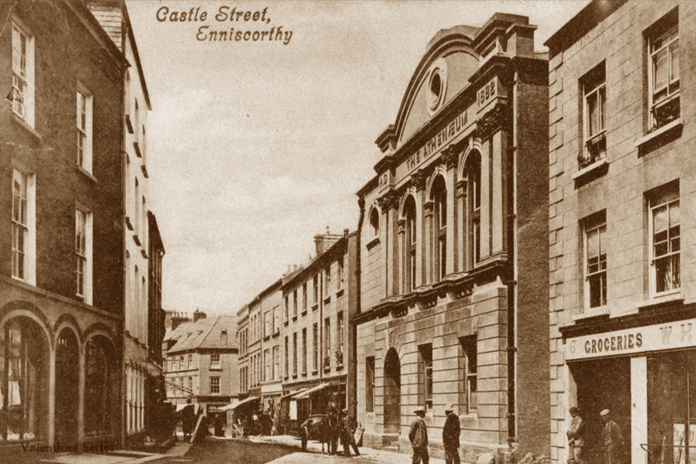
A postcard showing The Athenæum and its dominance over the narrow Castle Street. To assist the public’s appreciation of its architectural merits, The People (1st October 1892) called for the removal of the railings from the National Bank of Ireland on the opposite side of the street ‘for it would mean increased facilities for the street traffic and for passengers besides being attended with improvement from the point of view of appearance’. However, this was not effected until the bank moved to a purpose-built premises next door in the 1920s
Christened The Athenæum by committee treasurers Dr. Nicholas Furlong and Dr. Thomas J. Kelly, and so named after Athena, the Greek goddess of arts and wisdom, the unfinished hall was the subject of a lengthy article in The People (3rd September 1892) where a correspondent reported:
“Enniscorthy’s New Hall or Athenæum, as it is most appropriately designated, is now in the final constructive stages, and but a very short time will elapse until the splendid building will be thrown open to the public. So much has been said and written in favour of its claims that attention has been directed to the undertaking outside Enniscorthy and its contingent districts; whilst in far-off lands Enniscorthy natives, whom the vicissitudes of fortune have exiled from their homes, have had the keenest interest aroused in them by the intelligence sent them by home correspondents of the new departure, which, it is hoped, will confer incalculable social benefits on the town… What has been said and written of the edifice up to the present has naturally created a “great expectation”, and people have been looking forward anxiously to its inauguration”.
Taking its inspiration from Classical architecture, the Castle Street façade presents a temple-like appearance with a pillared and pedimented principal floor resting on a channelled base. Although the decorative detailing is somewhat overstated, the description of the façade given in The People still applies:
“First [the spectator] is struck with the titular inscription – “A.D. The Athenæum 1891 [sic]” – which stands out in good relief, and next his gaze is attracted to a well-designed circular-moulded pediment with a piercing in the centre, in which, if feasible, the committee may yet fix a clock. The moulded fascia beneath this, which bears the name and date, rests on six pilasters with richly foliated capitals, and below the fascia the observer notes three large circular-headed windows which light the main hall, and which are replete with richly-moulded architraves… Underneath the three circular windows is a very handsome balustrade with splendidly moulded bases, and the lower portion of the frontage beneath is neatly worked out in cement. It (the lower portion) comprises the principal entrance [and] the two fine windows of the reading room”.
The report continued to describe the internal apartments of The Athenæum including, on the ground floor, the hall, the reading room, two billiard rooms, the smoking room, and, on the first floor, the ‘MAIN HALL, which, naturally, is the portion of the building which will be the centre of public interest… In saying that it is one of the finest in the provinces we do not exaggerate, and for meetings and entertainments of all kinds it will not only supply a want which has been long felt in the locality, but provide an accommodation of which few Irish towns can boast’.
The Athenæum was a hive of social activity for the first seventy years of its life and hosted many leading touring companies from home and abroad who staged a variety of performances including concerts, dances, operatic recitals and variety shows. Count John McCormack (1884-1945), the internationally-renowned tenor, made an appearance at a Feis in 1905. Films were shown and lectures were held in the main hall including one given in 1901 by Dr. Douglas Hyde (1860-1949), co-founder and President of the Gaelic League. Micheál MacLiammóir (1899-1978) and Hilton Edwards (1903-82), remembered for their contribution to Irish literature and theatre, met for the first time at The Athenæum on the 17th June 1927 and through their continued partnership established the Gate Theatre Company in Dublin in 1928. In October 1997, on the seventieth anniversary of their meeting, a specially commissioned bronze relief plaque was unveiled by MacLiammóir’s niece, Mary-Rose McMaster, to commemorate the occasion.
However, by far the most significant event at The Athenæum was not theatrical, but political. The Emmet Commemoration Concert and Oration which took place on the 1st March 1916 saw one of the most impressive gatherings ever held in the main hall. The orator at the event was Patrick Pearse (1879-1916) who spoke passionately about Robert Emmet (1778-1803), his dedication to the cause of Irish freedom, and how it ultimately cost him his life. Amongst the captivated audience were several volunteers of the Enniscorthy Circle of the Irish Republican Brotherhood who provided a guard of honour for Pearse and secured The Athenæum to prevent any interference from the Royal Irish Constabulary or any other authority. Pearse informed the volunteers that orders for an armed uprising would be coming soon.
.jpg)
A photograph by Alfred Edwin Crane of Court Street showing the arrest of the Enniscorthy Leaders outside The Athenæum on 1st May 1916. All of the leaders were court martialled and sentenced to death with the sentence later commuted to five years’ penal servitude. The Enniscorthy Leaders were released under a general amnesty in June 1917. Alfred Crane Collection courtesy of Ibar Carty
Previously immortalised as a centre of conflict during the 1798 Insurrection, Enniscorthy was the only town occupied by the Republicans outside of Dublin during the 1916 Rising. Early on Thursday morning, 27th April 1916, The Athenæum was occupied by a band of Irish Volunteers and appropriated as their headquarters in the town. Members of Cumann na mBán raised the Tricolour on the flagpole above the building and shots were fired in salute. Nearby buildings were also occupied including the adjacent Enniscorthy Castle; the Church Institute on the corner of Castle Street and Church Street; and the courthouse on the corner of Court Street and Friary Hill. The Republican dominance over the town was short lived, however, as on the 1st May the British Army, under Colonel George Arthur French (1864-1950), regained control of Enniscorthy.
The heyday of The Athenæum had passed by the late 1960s and as a result of economic and social changes the building was closed in 2004 and faced an uncertain future. A meeting was called to discuss the options available at which a local re-enactment group, dressed in Óglaigh na hÉireann uniforms and carrying the Tricolour, presented a banner styling The Athenæum as Enniscorthy’s GPO and calling for it to be saved. A week later, on the 12th November 2008, The Athenæum Restoration Fund Committee was formed with the sole purpose of raising funds to secure the future of the building as a civic facility benefitting the local community. Planning permission was secured for the adaptation and restoration of the Athenæum for twenty-first century use.
The restored Athenæum opened its doors to the public as a dedicated 1916 Museum on 27th April 2016. Among the attractions available to visitors are:
THE 1916 EXHIBITION IN THE BILLIARD ROOMS
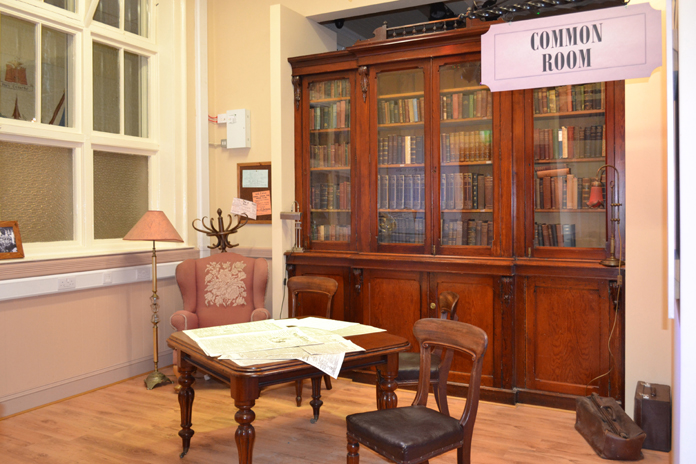
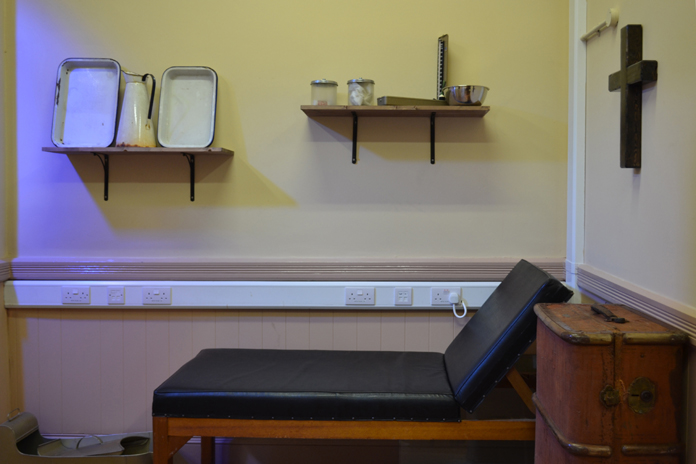
A 1916 Exhibition has been skilfully inserted into the space formerly occupied by a pair of billiard rooms. Organised into separate zones given such titles as Common Room, Emergency Hospital; Secretary’s Office and War Council, the artefacts on display include the original flag of the 1st Battalion Enniscorthy restored by textile conservator Rachel Phelan of Dublin; and, most poignantly, a letter signed by the Enniscorthy Leaders – Captain Robert Brennan (1881-1964); Captain Seamus Doyle (1885-1971); Lieutenant Michael de Lacy (1879/80-1951); Captain Seamus Rafter (1873-1918); Captain Seán Redmond Etchingham (1868-1923); and Captain Richard Francis (Dick) King (1890-1938) – requesting permission to send an envoy to meet with Patrick Pearse at Arbour Hill, Dublin, to confirm an order of surrender.
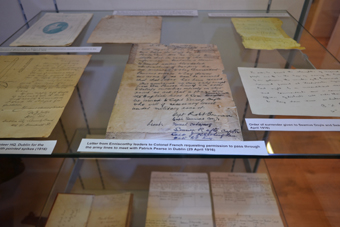
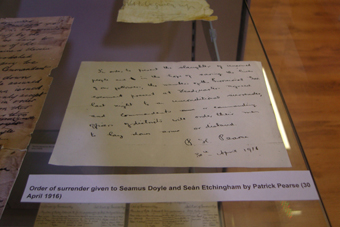
Original architectural features and fittings abound including acanthus-detailed bookcases and timber boarded ceilings described in The People as ‘red dale [deal] sheetings’. Visible in the accompanying photographs, but originally concealed from view, are the slender cast-iron pillars supplied by Jessop Davis (closed 1962) of Enniscorthy which once supported the main hall overhead. Although the main hall is now supported by a system of RSJs [rolled steel joists], the pillars were retained not only as decorative devices, but also to demonstrate late nineteenth-century construction techniques.
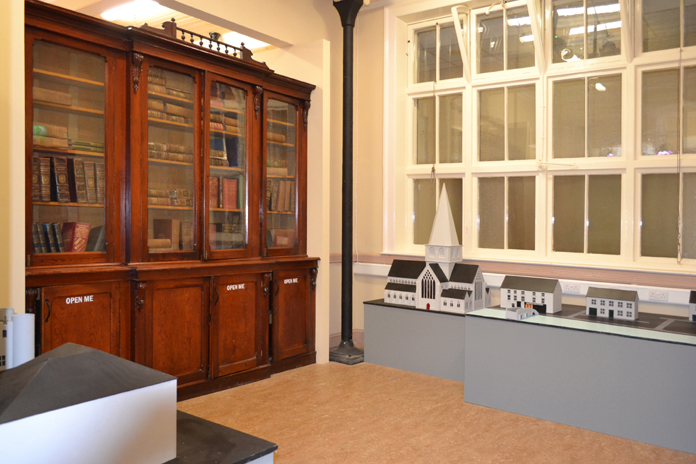
.jpg) |
 Detail.jpg)
Visitors to The Athenæum will also see a limited edition copy of The Proclamation (2009) by Rowan Fergus Meredith Gillespie (b. 1953), the full version of which can be seen outside Kilmainham Gaol, Dublin. The sculpture was donated by Stewart and Avice Harrington to Wexford County Council through the Friends of County Wexford Art Collection Scheme |
THE MULTIMEDIA ROOM IN THE SMOKING ROOM
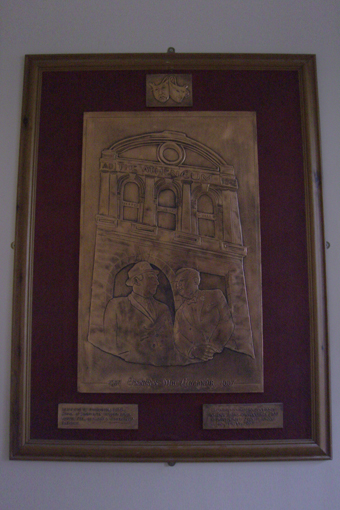
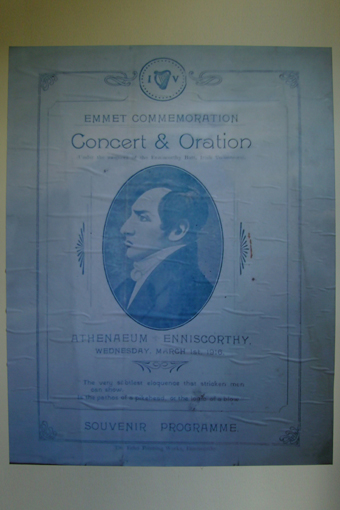
Housed in the former Smoking Room, a video presentation gives a history of The Athenæum, its place in the events of 1916 and, foremost, the important role played by women in the Rising in Enniscorthy. The room also includes the bronze relief plaque commemorating the meeting of Micheál MacLiammóir and Hilton Edwards and a facsimile of a souvenir programme cover from the Emmet Commemoration Concert and Oration at which the orator was Patrick Pearse.
THE INNER HALL
Not wishing to overlook any detail of The Athenæum, The People brought its readers’ attention to the inner hall and its ‘solidly-constructed staircase…in two flights of 21 steps. Its material is the best pitch pine, with mahogany handrail and ornamental iron balusters… What has been said [of the timber work in The Athenæum] applies equally to the staircase, which has all the ornamental and durable qualities that one would look for in the staircase of a public building, such as the Athenæum is or will be’.
THE MAIN HALL
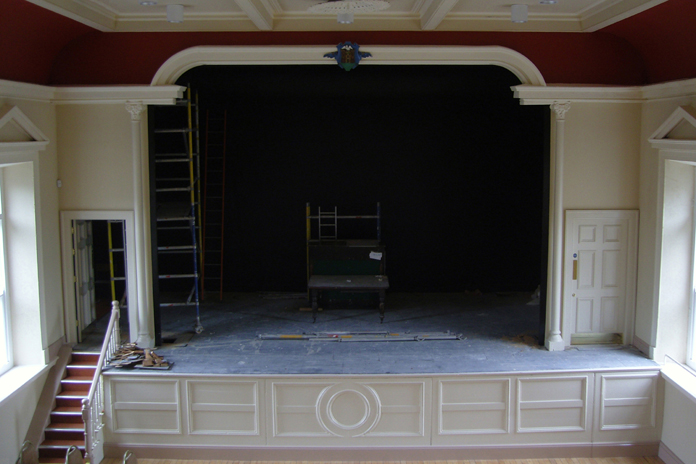
In its report on the architecture of The Athenæum, The People reserved its highest praise for the Main Hall. Following its recent restoration, the description still applies today:
“The hall is most spacious, being 72 feet by 31 feet, and 22 feet high to ceiling, and is very fine and excellently ventilated. The ceiling of the hall will be very much admired for its beauty, being coved, richly panelled and moulded, and ornamented by two very handsome fibrous plaster centres… At the left and right hand sides, it has three large square-headed windows respectively, and at the end – at the back of the stage – three more circular windows appear. So that in the matter of light, the architect has been commendably and scrupulously careful… Taking up a position in the centre of the hall and looking towards the STAGE the observer has a good opportunity of judging its merits and demerits – the latter being, indeed, at a minimum. It is 14 feet by 31 feet, and has a moulded and panelled front. The floor of it is 4 feet above the level of the main hall and in front of the platform two openings have been provided by which access can be had to the dressing-rooms underneath… The flooring of the main hall and stage is 1¼ inch tongue and grooved red deal, in narrow widths”.
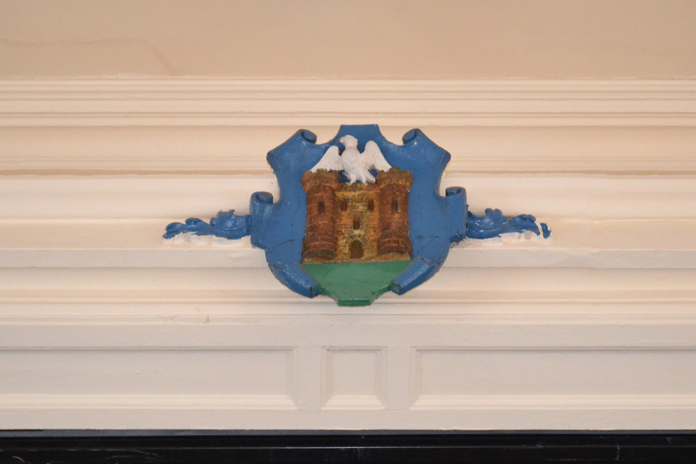
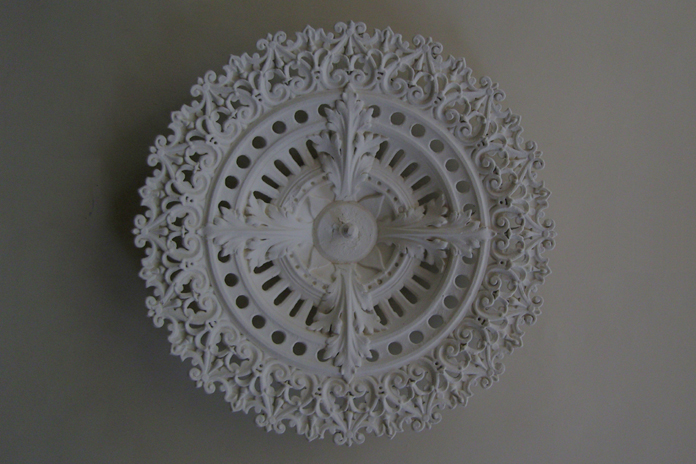
The Athenæum is open daily from 10am to 5pm Monday to Friday; from 11am to 5pm on Saturday; and from 12pm to 5pm on Sunday. Click here for more information.
.jpg)
.jpg)
Sarah Buckley is a third year Culture and Heritage Honours Degree student studying at Wexford Campus, IT Carlow, and has recently completed an internship with the National Inventory of Architectural Heritage
ACKNOWLEDGEMENTS
The National Inventory of Architectural Heritage would like to thank Helen Ashdown, Director of The Athenæum; and Tony McClean, Chairperson of The Athenæum Restoration Fund Committee, for their kind assistance with this Building of the Month
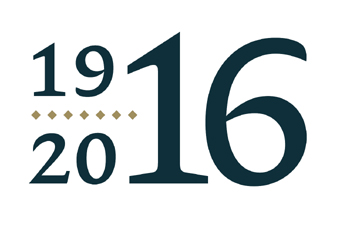
Back to Building of the Month Archive